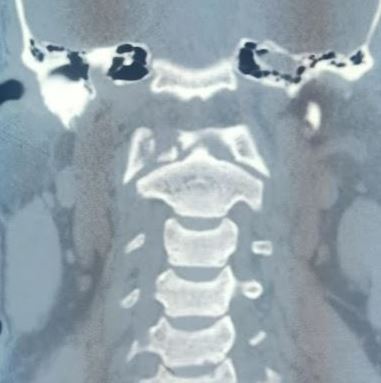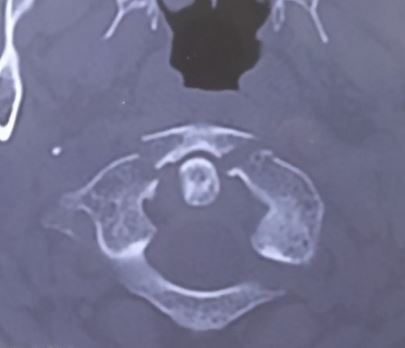[2]
Kaiser JT, Reddy V, Launico MV, Lugo-Pico JG. Anatomy, Head and Neck: Cervical Vertebrae. StatPearls. 2024 Jan:():
[PubMed PMID: 30969556]
[3]
Lyons JG, Mian HM. Epidemiology of atlas fractures in the United States: A 20-year analysis. Journal of craniovertebral junction & spine. 2022 Jan-Mar:13(1):85-93. doi: 10.4103/jcvjs.jcvjs_164_21. Epub 2022 Mar 9
[PubMed PMID: 35386248]
[4]
Fiedler N, Spiegl UJA, Jarvers JS, Josten C, Heyde CE, Osterhoff G. Epidemiology and management of atlas fractures. European spine journal : official publication of the European Spine Society, the European Spinal Deformity Society, and the European Section of the Cervical Spine Research Society. 2020 Oct:29(10):2477-2483. doi: 10.1007/s00586-020-06317-7. Epub 2020 Jan 30
[PubMed PMID: 32002697]
[5]
Cloney MB, El-Tecle N, Dahdaleh NS. Traumatic atlas fracture patients comprise two subpopulations with distinct demographics and mechanisms of injury. Clinical neurology and neurosurgery. 2022 Oct:221():107414. doi: 10.1016/j.clineuro.2022.107414. Epub 2022 Aug 17
[PubMed PMID: 35987045]
[6]
Matthiessen C, Robinson Y. Epidemiology of atlas fractures--a national registry-based cohort study of 1,537 cases. The spine journal : official journal of the North American Spine Society. 2015 Nov 1:15(11):2332-7. doi: 10.1016/j.spinee.2015.06.052. Epub 2015 Jun 29
[PubMed PMID: 26133259]
Level 3 (low-level) evidence
[7]
Ylönen H, Danner N, Jyrkkänen HK, Kämäräinen OP, Leinonen V, Huttunen J. Surgically Treated C1 Fractures: A Population-Based Study. World neurosurgery. 2021 Oct:154():e333-e342. doi: 10.1016/j.wneu.2021.07.046. Epub 2021 Jul 17
[PubMed PMID: 34284160]
[8]
Laubach M, Pishnamaz M, Scholz M, Spiegl U, Sellei RM, Herren C, Hildebrand F, Kobbe P. Interobserver reliability of the Gehweiler classification and treatment strategies of isolated atlas fractures: an internet-based multicenter survey among spine surgeons. European journal of trauma and emergency surgery : official publication of the European Trauma Society. 2022 Feb:48(1):601-611. doi: 10.1007/s00068-020-01494-y. Epub 2020 Sep 12
[PubMed PMID: 32918554]
Level 3 (low-level) evidence
[10]
Ma W, Xu N, Hu Y, Li G, Zhao L, Sun S, Jiang W, Liu G, Gu Y, Liu J. Unstable atlas fracture treatment by anterior plate C1-ring osteosynthesis using a transoral approach. European spine journal : official publication of the European Spine Society, the European Spinal Deformity Society, and the European Section of the Cervical Spine Research Society. 2013 Oct:22(10):2232-9. doi: 10.1007/s00586-013-2870-x. Epub 2013 Jun 18
[PubMed PMID: 23775293]
[11]
Kandziora F, Scholz M, Pingel A, Schleicher P, Yildiz U, Kluger P, Pumberger M, Korge A, Schnake KJ, Spine Section of the German Society for Orthopaedics and Trauma. Treatment of Atlas Fractures: Recommendations of the Spine Section of the German Society for Orthopaedics and Trauma (DGOU). Global spine journal. 2018 Sep:8(2 Suppl):5S-11S. doi: 10.1177/2192568217726304. Epub 2018 Sep 7
[PubMed PMID: 30210964]
[12]
Eun J, Oh Y. The relationship between radiologic parameters and transverse atlantal ligament injury obtained from MRI scans in patients with an isolated atlas burst fracture: A retrospective observational study. Medicine. 2021 Dec 10:100(49):e28122. doi: 10.1097/MD.0000000000028122. Epub
[PubMed PMID: 34889272]
Level 2 (mid-level) evidence
[13]
Lin P, Chuang TC, Baker JF. C1:C2 ratio is a potential tool assessing atlas fracture displacement and transverse ligament injury. Journal of craniovertebral junction & spine. 2019 Jul-Sep:10(3):139-144. doi: 10.4103/jcvjs.JCVJS_59_19. Epub
[PubMed PMID: 31772425]
[14]
Cloney M, Kim H, Riestenberg R, Dahdaleh NS. Risk Factors for Transverse Ligament Disruption and Vertebral Artery Injury Following an Atlas Fracture. World neurosurgery. 2021 Feb:146():e1345-e1350. doi: 10.1016/j.wneu.2020.11.172. Epub 2020 Dec 9
[PubMed PMID: 33309644]
[15]
Rusconi A, Peron S, Roccucci P, Stefini R. The internal carotid artery and the atlas: anatomical relationship and implications for C1 lateral mass fixation. Surgical and radiologic anatomy : SRA. 2021 Jan:43(1):87-92. doi: 10.1007/s00276-020-02537-0. Epub 2020 Jul 30
[PubMed PMID: 32734343]
[16]
Tomaszewski R, Sesia SB, Studer D, Rutz E, Mayr JM. Conservative treatment and outcome of upper cervical spine fractures in young children: A STROBE-compliant case series. Medicine. 2021 Apr 2:100(13):e25334. doi: 10.1097/MD.0000000000025334. Epub
[PubMed PMID: 33787631]
Level 2 (mid-level) evidence
[17]
Starnoni D, Ecker T, Barges-Coll J. Navigation-Assisted Posterior Open Reduction and Internal Fixation in a C-CLAMP Fashion for an Isolated C1 Fracture. Journal of neurological surgery. Part B, Skull base. 2021 Feb:82(Suppl 1):S61-S62. doi: 10.1055/s-0040-1701692. Epub 2020 Mar 20
[PubMed PMID: 33692933]
[18]
Du YQ, Li T, Ma C, Qiao GY, Yin YH, Yu XG. Biomechanical evaluation of two alternative techniques to the Goel-Harms technique for atlantoaxial fixation: C1 lateral mass-C2 bicortical translaminar screw fixation and C1 lateral mass-C2/3 transarticular screw fixation. Journal of neurosurgery. Spine. 2020 Jan 17:32(5):682-688. doi: 10.3171/2019.11.SPINE191178. Epub 2020 Jan 17
[PubMed PMID: 31952043]
Level 2 (mid-level) evidence
[19]
Conroy E, Laing A, Kenneally R, Poynton AR. C1 lateral mass screw-induced occipital neuralgia: a report of two cases. European spine journal : official publication of the European Spine Society, the European Spinal Deformity Society, and the European Section of the Cervical Spine Research Society. 2010 Mar:19(3):474-6. doi: 10.1007/s00586-009-1178-3. Epub 2009 Oct 25
[PubMed PMID: 19856190]
Level 3 (low-level) evidence
[20]
Butt BB, Gagnet P, Piche J, Patel R, Park P, Aleem IS. Lateral mass screw placement in the atlas: description of a novel surgical technique, radiographic parameters, and review of the literature. Journal of spine surgery (Hong Kong). 2021 Sep:7(3):335-343. doi: 10.21037/jss-20-566. Epub
[PubMed PMID: 34734138]
[21]
Hu Y, Kepler CK, Albert TJ, Yuan ZS, Ma WH, Gu YJ, Xu RM. Accuracy and complications associated with the freehand C-1 lateral mass screw fixation technique: a radiographic and clinical assessment. Journal of neurosurgery. Spine. 2013 Apr:18(4):372-7. doi: 10.3171/2013.1.SPINE12724. Epub 2013 Feb 1
[PubMed PMID: 23373564]
[22]
Rajasekaran S, Soundararajan DCR, Shetty AP, Kanna RM. Motion-Preserving Navigated Primary Internal Fixation of Unstable C1 Fractures. Asian spine journal. 2020 Aug:14(4):466-474. doi: 10.31616/asj.2019.0189. Epub 2020 Feb 14
[PubMed PMID: 32050311]
[23]
Barrenechea IJ, Márquez L, Bruna AE. Unilateral C1 split fracture osteosynthesis using a patient-specific three-dimensional-printed guide: Technique report. Journal of craniovertebral junction & spine. 2021 Oct-Dec:12(4):437-439. doi: 10.4103/jcvjs.jcvjs_76_21. Epub 2021 Dec 11
[PubMed PMID: 35068828]
[24]
Wu C, Deng JY, Li T, Zeng BF, Hu HG, Zhu YF, Wei Q. 3D-Printed Screw-Rod Auxiliary System for Unstable Atlas Fractures: A Retrospective Analysis. Orthopaedic surgery. 2021 May:13(3):1006-1015. doi: 10.1111/os.13015. Epub 2021 Apr 7
[PubMed PMID: 33826254]
Level 2 (mid-level) evidence
[25]
Azimi P, Yazdanian T, Benzel EC, Aghaei HN, Azhari S, Sadeghi S, Montazeri A. Accuracy and safety of C2 pedicle or pars screw placement: a systematic review and meta-analysis. Journal of orthopaedic surgery and research. 2020 Jul 20:15(1):272. doi: 10.1186/s13018-020-01798-0. Epub 2020 Jul 20
[PubMed PMID: 32690035]
Level 1 (high-level) evidence
[26]
Zou X, Ouyang B, Ma X, Chen Y, Ge S, Zhang S, Ni L, Xia H, Wu Z. [Progress in treatment of unstable atlas fracture]. Zhongguo xiu fu chong jian wai ke za zhi = Zhongguo xiufu chongjian waike zazhi = Chinese journal of reparative and reconstructive surgery. 2020 Jun 15:34(6):793-796. doi: 10.7507/1002-1892.201909129. Epub
[PubMed PMID: 32538574]
[27]
Zou X, Ouyang B, Wang B, Yang H, Ge S, Chen Y, Ni L, Zhang S, Xia H, Wu Z, Ma X. Motion-preserving treatment of unstable atlas fracture: transoral anterior C1-ring osteosynthesis using a laminoplasty plate. BMC musculoskeletal disorders. 2020 Aug 12:21(1):538. doi: 10.1186/s12891-020-03575-w. Epub 2020 Aug 12
[PubMed PMID: 32787814]
[28]
Tu Q, Chen H, Li Z, Chen Y, Xu A, Zhu C, Huang X, Ma X, Wang J, Zhang K, Yin Q, Xu J, Xia H. Anterior reduction and C1-ring osteosynthesis with Jefferson-fracture reduction plate (JeRP) via transoral approach for unstable atlas fractures. BMC musculoskeletal disorders. 2021 Aug 30:22(1):745. doi: 10.1186/s12891-021-04628-4. Epub 2021 Aug 30
[PubMed PMID: 34461878]
[29]
Shin JW, Suk KS, Kim HS, Yang JH, Kwon JW, Lee HM, Moon SH, Lee BH, Park SJ, Park SR, Kim SK. Direct Internal Fixation for Unstable Atlas Fractures. Yonsei medical journal. 2022 Mar:63(3):265-271. doi: 10.3349/ymj.2022.63.3.265. Epub
[PubMed PMID: 35184429]
[30]
Yan L, Du J, Yang J, He B, Hao D, Zheng B, Yang X, Hui H, Liu T, Wang X, Guo H, Chen J, Wang S, Ma S, Dong S. C1-ring osteosynthesis versus C1-2 fixation fusion in the treatment of unstable atlas fractures: a multicenter, prospective, randomized controlled study with 5-year follow-up. Journal of neurosurgery. Spine. 2022 Aug 1:37(2):157-165. doi: 10.3171/2021.12.SPINE211063. Epub 2022 Feb 11
[PubMed PMID: 35148517]
Level 1 (high-level) evidence
[31]
Junewick JJ, Chin MS, Meesa IR, Ghori S, Boynton SJ, Luttenton CR. Ossification patterns of the atlas vertebra. AJR. American journal of roentgenology. 2011 Nov:197(5):1229-34. doi: 10.2214/AJR.10.5403. Epub
[PubMed PMID: 22021519]
[32]
Macki M, Hamilton T, Pawloski J, Chang V. Occipital fixation techniques and complications. Journal of spine surgery (Hong Kong). 2020 Mar:6(1):145-155. doi: 10.21037/jss.2019.12.01. Epub
[PubMed PMID: 32309653]
[34]
Bhimani AD, Chiu RG, Esfahani DR, Patel AS, Denyer S, Hobbs JG, Mehta AI. C1-C2 Fusion Versus Occipito-Cervical Fusion for High Cervical Fractures: A Multi-Institutional Database Analysis and Review of the Literature. World neurosurgery. 2018 Nov:119():e459-e466. doi: 10.1016/j.wneu.2018.07.182. Epub 2018 Jul 30
[PubMed PMID: 30071333]
[35]
Purvis TE, De la Garza-Ramos R, Abu-Bonsrah N, Goodwin CR, Groves ML, Ain MC, Sciubba DM. External fixation and surgical fusion for pediatric cervical spine injuries: Short-term outcomes. Clinical neurology and neurosurgery. 2018 May:168():18-23. doi: 10.1016/j.clineuro.2018.02.005. Epub 2018 Feb 5
[PubMed PMID: 29505977]


